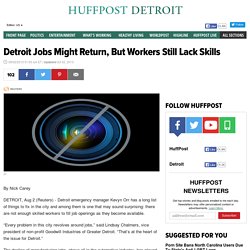

GM, Ford, and Chrysler: The Detroit Three Are Back, Right? “You can call me Alicia or Lady Stingray.

I answer to both.” Tall and slender, in a minidress that could have been designed by Miuccia Prada for Marvel Comics (DIS), Lady Stingray towers over her lord, the 2014 Chevrolet Corvette Stingray. Both are being ogled. It’s the opening day of this year’s New York International Auto Show, which runs through April 7. Lady Stingray circles the sports car, trailing one hand along it, talking about extruded aluminum and paddle shifters and carbon fiber. Photograph by Paul Sancya/AP PhotoGM's Corvette Stingray and admirers General Motors (GM) is hoping the Corvette’s sex appeal draws in a whole new sort of buyer, the kind that currently prowls the roadways in an Audi (NSU:GR) or a BMW (BMW:GR). Four years ago, GM and Chrysler had to go through bankruptcy, and the federal government was in the process of pouring $80 billion into the industry.
Loaded: 0% Progress: 0% There have been other savings, too. Detroit and Central Falls. When Detroit announced that its $14 billion-plus of debt and $380 million annual budget deficit was forcing it to file for bankruptcy yesterday, only a few people around the country could understand how it feels when your city runs out of money -- the residents of Central Falls, R.I. a city of under 20,000 people were some of them.

Though much smaller, Central Falls filed for bankruptcy in 2011 citing many of the same problems now seen in Detroit -- mismanagement, reduced state and federal aid and skyrocketing health care and pension costs. Since a municipal bankruptcy on Detroit's sale is largely without precedent, Central Falls is one of the few places in the country to observe what might be in store for Detroit. If Central Falls teaches one lesson, it's that the decision to peal off the Band-Aid and declare bankruptcy hurts, but it's the rip -- the lay-offs, slashed pensions and reduced services -- that causes real pain. Two Different Cities One Problem What to Do. Brian Balasia And Digerati Break Down The Jobs Crisis. In a region known for its automotive industry, it is only fitting that a local entrepreneur found a solution while analyzing car parts.

While interning at a manufacturing and factory redesign company in Detroit, Brian Balasia realized that the same techniques used on the product line could help companies use new technology more efficiently. So at the age of 20, Balasia founded Digerati, a process-consulting company with the mission of analyzing and fixing the inefficient use of new tools and methods in the workplace. Balasia, Digerati's co-founder and CEO, recognized that the way companies implemented new technology sometimes resulted in more lost time and money than before they had the new tool or method. Even when jobs return, Detroit's workers fall short on skills. August 02, 2013|Nick Carey | Reuters DETROIT (Reuters) - Detroit emergency manager Kevyn Orr has a long list of things to fix in the city and among them is one that may sound surprising: there are not enough skilled workers to fill job openings as they become available.

Detroit Jobs Might Return, But Workers Still Lack Skills. DETROIT, Aug 2 (Reuters) - Detroit emergency manager Kevyn Orr has a long list of things to fix in the city and among them is one that may sound surprising: there are not enough skilled workers to fill job openings as they become available.

“Every problem in this city revolves around jobs,” said Lindsay Chalmers, vice president of non-profit Goodwill Industries of Greater Detroit. “That’s at the heart of the issue for Detroit.” The decline of manufacturing jobs, above all in the automotive industry, has played a major role in the slide of the Motor City’s population to 700,000 from a peak of 1.8 million in the 1950s. Despite recent gains, Michigan has 350,000 fewer manufacturing jobs than in 2000.
Seismic shifts in the local labor market have left many unskilled workers behind. Report: Nearly Half Of Detroiters Can’t Read. DETROIT (WWJ) – According to a new report, 47 percent of Detroiters are “functionally illiterate.”

The alarming new statistics were released by the Detroit Regional Workforce Fund on Wednesday. WWJ Newsradio 950 spoke with the Fund’s Director, Karen Tyler-Ruiz, who explained exactly what this means. “Not able to fill out basic forms, for getting a job — those types of basic everyday (things). Reading a prescription; what’s on the bottle, how many you should take… just your basic everyday tasks,” she said. “I don’t really know how they get by, but they do. Some of the Detroit suburbs also have high numbers of functionally illiterate: 34 percent in Pontiac and 24 percent in Southfield. “For other major urban areas, we are a little bit on the high side… We compare, slightly higher, to Washington D.C.’s urban population, in certain ZIP codes in Washington D.C. and in Cleveland,” she said.
Tyler-Ruiz said only 10 percent of those who can’t read have gotten any help to resolve it. Basicskillsreport_final. Raw Data: Detroit's unemployment rate over the last decade. Unemployment Rate in Detroit-Warren-Livonia, MI (MSA) Unemployment Rate in Detroit-Warren-Livonia, MI (MSA) Range Units Go to Regular Site Legal | Privacy © 2014 Federal Reserve Bank of St.

Detroit Unemployment. 2012-american-manufacturing-decline. 10 reasons for Detroit's historic failures. By Eric Boehm | Watchdog.org The city of Detroit declared Chapter 9 bankruptcy on Thursday, making it the largest city in American history to go through the municipal bankruptcy process.

On Friday, a judge ruled that filing unconstitutional, but as the city sorts out its next move, here are 10 facts about the causes of Detroit’s financial mess and 10 photos that reflect just how badly the city is doing these days. NOT SO GRANDE: The main dance floor at The Grande Ballroom in downtown Detroit has seen better days. 1. The population has collapsed in the past six decades. Detroit was America’s fourth largest city in 1950, when it had 1.8 million people. Yes, fewer people means a smaller tax base, but the real problem is the city’s government did not shrink along with the population — more on that in a bit.
THEY USED TO MAKE CARS HERE: The Packard Automobile Factory, where thousands of auto workers once labored, is a ghostly reminder of the city’s past as a manufacturing center. 2. 3. 4. 5. 6. The Reasons Behind Detroit’s Decline by Pete Saunders. My hometown of Detroit has been studied obsessively for years by writers and researchers of all types to gain insight into the Motor City’s decline.

Indeed, it seems to have become a favorite pastime for urbanists of all stripes. How could such an economic powerhouse, a uniquely American city, so utterly collapse? Most analysis tends to focus on the economic, social and political reasons for the downfall. 25 Facts About The Fall Of Detroit That Will Leave You Shaking Your Head. By Michael Snyder, on July 20th, 2013 It is so sad to watch one of America’s greatest cities die a horrible death.
